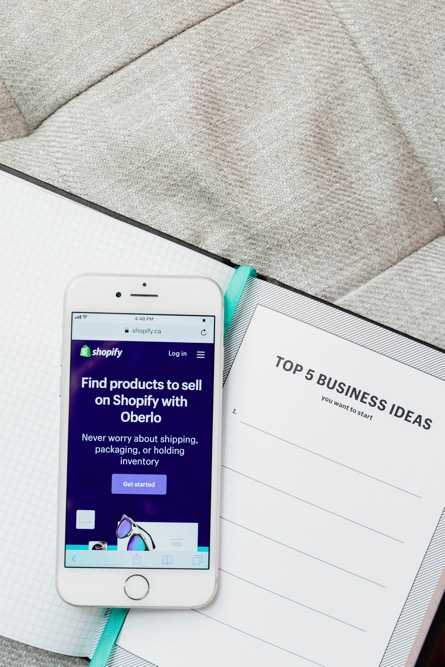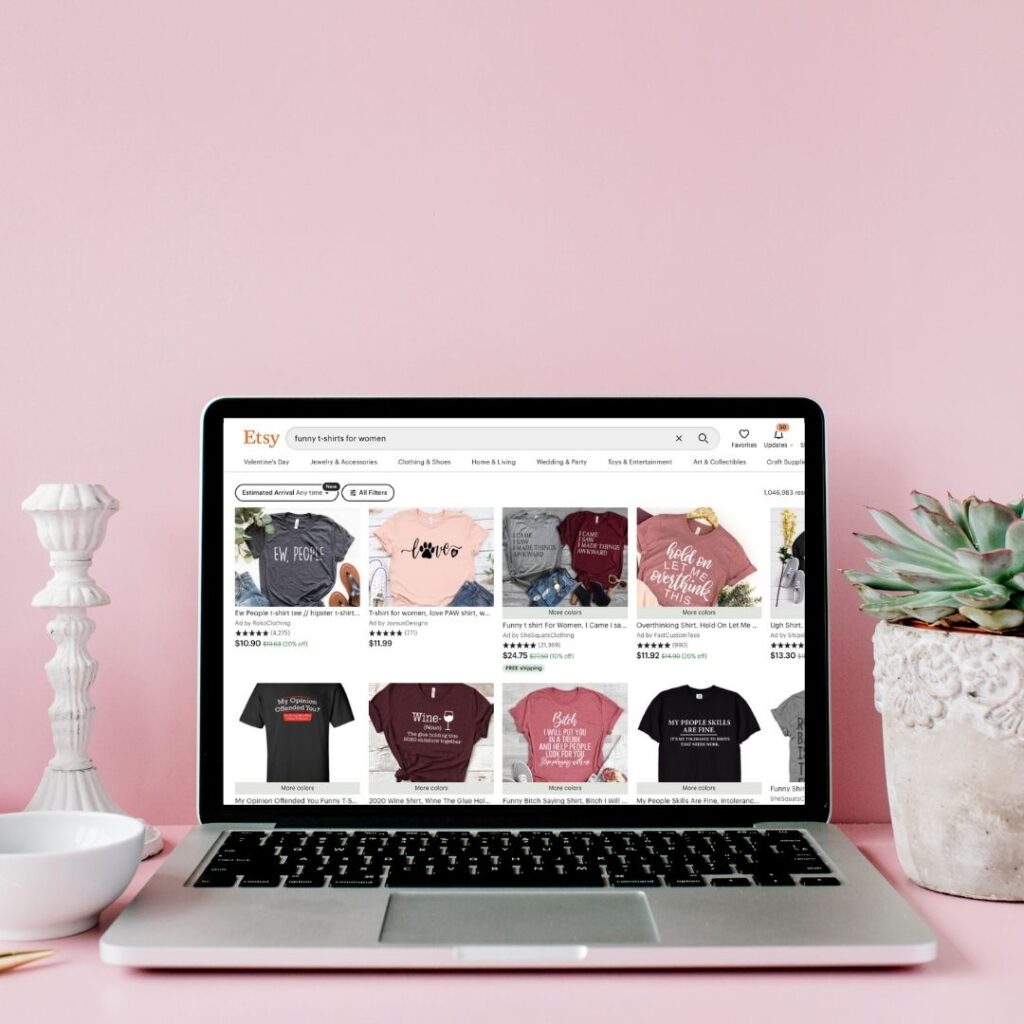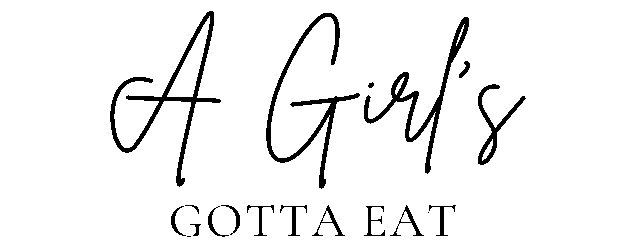Etsy vs. Shopify: Which One is Best for Your E-Commerce Business?
One topic I’m frequently asked about by readers of this blog is my opinion on Etsy vs. Shopify and which one is better for starting a print-on-demand (POD) store. This post will cover my experience selling POD and digital products on both platforms, the main differences between the two, and what I recommend for you based on your shop goals and needs.

(This post contains affiliate links)
Etsy vs. Shopify: What’s the Difference?
The main difference between Etsy and Shopify is that Etsy is a marketplace and Shopify is an e-commerce website builder.
Etsy allows for the sale of handmade goods, vintage goods, and craft supplies. They are a marketplace in the sense that they host your shop along with thousands of other shops, so it’s like setting up your storefront at a craft fair or a mall instead of in your own building on the side of the road.
Etsy Fees: It costs 20 cents to list an item for sale for 4 months on Etsy. When you make a sale, you are charged a 5% transaction fee, plus a 3% payment processing fee. These vary slightly depending on the location of your bank, so you can read the full fee structure here. Overall, the fees come out to around 8-10% of your total sale.

Shopify is different from Etsy in that it’s creating your own standalone website for your store. It allows you to sell a wider range of goods than Etsy, as long as they’re legal. If you sell handmade products you can use Shopify to set up your own storefront, or if you want to do something like buy wholesale from a variety of brands and sell them under your own boutique, Shopify is perfect for this as well. There is more flexibility and autonomy with Shopify than there is with Etsy, which is why a lot of sellers opt for this. The drag-and-drop designer makes it easy to customize your website exactly how you want it to look without having to learn code.
Shopify Fees: You can try Shopify free for 14 days, but after that, it costs a minimum of $29 per month, plus roughly 3% in payment processing fees. So their fees are less than half of Etsy’s (not including the monthly subscription fee), which is a big advantage if you sell a large volume of products, but if you’re brand new and only selling a few items a month, it’s much more costly to get up and running than an Etsy shop.
How to Decide if Etsy or Shopify is Right for Your Business
The main thing to consider is what you’re selling. Etsy limits the type of products that can be sold in their marketplace, so you can’t sell on there if your products are not considered handmade, vintage, or craft supplies. If your products don’t fall into that category, the decision to use Shopify has already been made for you.
I sell both digital products and print-on-demand products on Etsy and Shopify, and I know a lot of you either currently sell or are interested in selling those types of products as well. Both types of products are permitted on Etsy, as long as you disclose that the POD products are handmade with the help of a production partner (I create the designs, my production partner prints the shirts).
From my own experience, I always encourage new digital and POD sellers to start on Etsy because the marketplace aspect provides tons of benefits to new sellers.
Etsy has a built-in audience of 45 million shoppers, so there’s a huge advantage to the automatic traffic you’ll get from a marketplace like Etsy that people already trust. This is helpful if you’re brand new to e-commerce and have no idea if your brand will be successful, you don’t have a big audience to sell to, and you don’t want to spend a bunch of money on a website before you know if it’s going to work.
However, that doesn’t mean there are no downsides to selling on Etsy: they have higher fees than Shopify and you’re bound to their stricter terms and conditions, which means they can shut your shop down at any time if they think you’ve violated the rules. You’ll get warned anytime you do something that could warrant a shop ban, so make sure your shop is always in compliance with their house rules.
Shopify allows you to sell any products you want on a standalone website. There is no built-in audience or traffic, so it’s a lot easier to get started on Shopify if you already have an established brand or a large audience you can sell to. You can create your own domain instead of a domain name with Etsy.Com tacked onto it.
You can easily sync your Shopify products to Instagram, Facebook, Google, and Pinterest, and the access you get to their apps offers a variety of options to grow your brand by sourcing new products to dropship or connecting with influencers to promote your stuff.
There’s a LOT you can do with Shopify, and their drag-and-drop website builder makes it super easy to create a custom storefront without knowing any code.
In my experience it takes a little bit of playing around to get the hang of how to organize your products into collections and how to customize your theme, but it’s a lot easier than WordPress/WooCommerce and is worth it for the price.
Do you need both Etsy and Shopify?
Once your shop is established on Etsy and you’re making regular sales, you’ll get a feel for whether this is something you want to keep growing and doing long-term. Once you’re making regular sales and Etsy is making up more than a casual portion of your income, it’s time to start working on your backup plan/website. I recommend you start a Shopify store once your Etsy shop has gained some traction and the idea of Etsy shutting your store down makes you sweat a little bit.
By the time you’ve reached this point, you’ll have plenty of data in your shop stats, custom order messages, and customer feedback to know who your ideal customer is and what they want from you. Use this information to create your own storefront on Shopify, which is your new safety net in case something happens with your Etsy shop. It will be a lot easier to drive traffic to a Shopify store when you already have all this information from your Etsy customers.
It’s also helpful to diversify the number of places where you sell your products. The more places they’re available, the more chances there are for your products to pop up in someone’s Google Shopping results. Diversification is essential for growing your business and making more money.
In conclusion, you should first start an Etsy shop if:
You’re brand new to online selling and have no idea if anyone will buy your products.
You don’t want to spend much money upfront to launch your business.
Your products classify as:
- Handmade (digital products are considered handmade)
- Handmade with a production partner (print-on-demand products fall under this category)
- Vintage that’s 20+ years old
- Craft supplies
When you go to open your Etsy shop, make sure to use my seller referral link and we’ll both get 40 free listings.
Start a Shopify store if:
You’re selling wholesale or dropshipped products you did not design or create yourself.
You have a large social following, established brand, or some other social proof that ensures you already have an audience to sell to.
You’ve been selling on Etsy for a while, you know what your target customer is looking for and which products are your best sellers, and you’re ready to grow your business and backup plan.
Start your free 14-day trial of Shopify here.
Check out more of my posts for online business inspiration and e-commerce tips:
How to start an apparel boutique with print-on-demand
5 reasons print-on-demand is the perfect starter business






